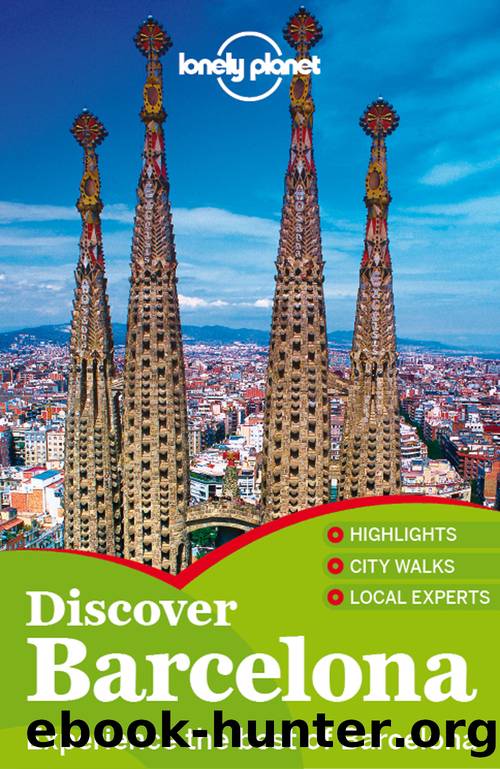Discover Barcelona Travel Guide by Lonely Planet

Author:Lonely Planet
Language: eng
Format: epub
Publisher: Lonely Planet
L'Eixample
Top Sights
La Sagrada FamÃliaF1
Sights
1 Museu de Carrosses Fúnebres H3
2 Museu de la Música H2
Eating
3 Amaltea C5
4 Can Kenji E2
5 Cerveseria Brasseria Gallega B3
6 Cremeria Toscana B4
7 Escribà D6
8 Melton B3
9 Terrabacus B3
Drinking & Nightlife
10 Café San Telmo B3
11 Metro D5
12 Museum D6
Entertainment
L'Auditori (see 2)
13 Renoir Floridablanca D6
14 Teatre Nacional De Catalunya H2
Shopping
15 Els Encants Vells H1
MUSEU DEL PERFUM Museum
Offline map Google map ( 93 216 01 21; www.museudelperfum.com; Passeig de Grà cia 39; adult/student & senior â¬5/3; 10.30am-1.30pm & 4.30-8pm Mon-Fri, 11am-2pm Sat; Passeig de Grà cia) Housed in the back of the Regia (Click here) perfume store, this museum contains everything from ancient Egyptian and Roman (the latter mostly from the 1st to 3rd centuries AD) scent receptacles to classic eau-de-cologne bottles â all in all, some 5000 bottles of infinite shapes, sizes and histories.
MUSEU DEL MODERNISME CATALÃ Museum
( 93 272 28 96; www.mmcat.cat; Carrer de Balmes 48; adult/child under 5yr/child 5-16yr/student â¬10/free/5/7; 10am-8pm Mon-Sat, to 3pm Sun; Passeig de Grà cia) Housed in a Modernista building, the ground floor seems like a big Modernista furniture showroom. Several items by Antoni GaudÃ, including chairs from Casa Batlló and a mirror from Casa Calvet, are supplemented by a host of items by his lesser-known contemporaries, including some typically whimsical, mock medieval pieces by Puig i Cadafalch.
The basement, showing off Modernista traits like mosaic-coated pillars, bare brick vaults and metal columns, is lined with Modernista art, including paintings by Ramon Casas and Santiago Rusiñol, and statues by Josep Llimona and Eusebi Arnau.
UNIVERSITAT DE BARCELONA Architecture
( 93 402 11 00; www.ub.edu; Gran Via de les Corts Catalanes 585; 9am-9pm Mon-Fri; Universitat) Although a university was first set up on what is now La Rambla in the 16th century, the present, glorious mix of (neo) Romanesque, Gothic, Islamic and Mudéjar architecture is a caprice of the 19th century (built 1863â82). Wander into the main hall, up the grand staircase and around the various leafy cloister, or take a stroll in the rear gardens. On the 1st floor, the main hall for big occasions is the Mudéjar-style Paranimfo.
Download
This site does not store any files on its server. We only index and link to content provided by other sites. Please contact the content providers to delete copyright contents if any and email us, we'll remove relevant links or contents immediately.
Searching for Family and Traditions at the French Table by Carole Bumpus(652)
Great Pilgrimage Sites of Europe by Derry Brabbs(557)
Paris Without Her: A Memoir by Gregory Curtis(553)
Searching for Family and Traditions at the French Table, Book One (Champagne, Alsace, Lorraine, and Paris regions) by Carole Bumpus(523)
Notre-Dame of Paris (The Hunchback of Notre Dame) by Victor Hugo(518)
France--Culture Smart! by Culture Smart!(495)
One Italian Summer by Lori Nelson Spielman(490)
London by Matthew Green(482)
The Bookseller of Florence by Ross King(472)
Lonely Planet's Ultimate Travel by Lonely Planet(438)
Around Britain by Canal by Unknown(420)
Adventures on the High Teas: In Search of Middle England by Stuart Maconie(415)
Clanlands by Sam Heughan and Graham McTavish(414)
Switzerland--Culture Smart! by Culture Smart!(398)
Florida by Lonely Planet(395)
London's Underground by Oliver Green(394)
The Little Book of London by David Long(386)
Taking Paris by Martin Dugard(377)
Queen Victoria by Lytton Strachey(370)
